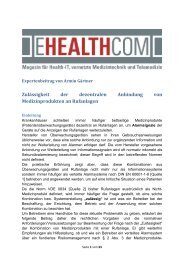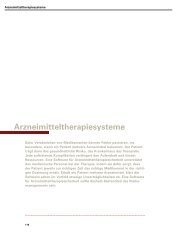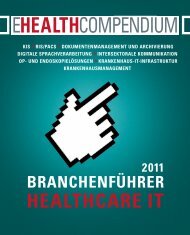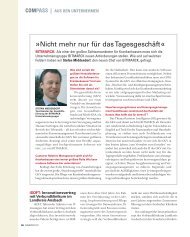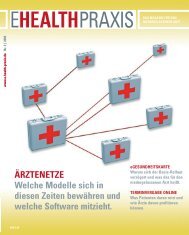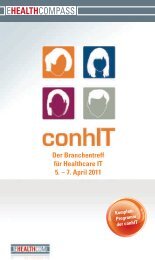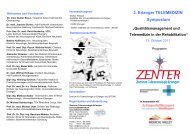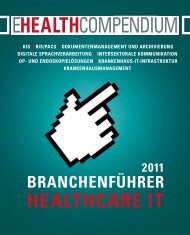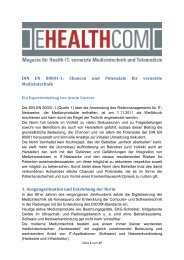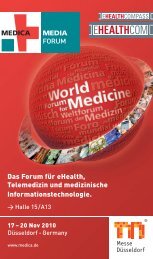eHealth Task Force Report - E-Health-Com
eHealth Task Force Report - E-Health-Com
eHealth Task Force Report - E-Health-Com
You also want an ePaper? Increase the reach of your titles
YUMPU automatically turns print PDFs into web optimized ePapers that Google loves.
pathways for general care and urgent care. <strong>e<strong>Health</strong></strong> tools such<br />
as telemonitoring, remote health services and self monitoring<br />
will be important in reducing the burden on hospitals. Fully<br />
integrating data management tools with provision of care<br />
services is essential Transparent reporting of the data leads<br />
to greater trust in the health system and allows the managers<br />
to focus on where improvements are needed and opportunities<br />
to deliver more efficiently. An improvement of just a few<br />
percentage points in the management of chronic conditions<br />
would fully cover the cost of collecting, aggregating and releasing<br />
anonymised data.<br />
The .main .precondition .for .this .lever .for .change .is that<br />
regulators and policymakers to require institutions to publish<br />
their data; for professionals and service providers to ensure<br />
robust data, gathered in a standardised way, integrated with<br />
care services, and made available to researchers with the<br />
informed consent of citizens and patients – the owners of the<br />
data.<br />
The .main .benefits .from .this .lever .for .change .are from<br />
accelerated innovation and increased scale (from standardisation)<br />
and spread across all actors in the form of lower costs,<br />
integrated services, rich data flows for research and policy<br />
making, new services, more choice through more competition,<br />
better and more evidence. Citizens and patients will benefit<br />
from health being more ‘user’ focused and availability of new<br />
drugs and treatments.<br />
Important .issues .to .consider:<br />
Quality of data – Data needs to be collected in a standardised<br />
way so that it can be comparable and usable, e.g infection statistics<br />
in hospitals, outcomes per surgeon or intervention. Much<br />
health information is already produced in a standardised way<br />
for submission to public bodies (surveillance authorities etc)<br />
PATIENT<br />
PUBLIC SERVICES<br />
PATIENT<br />
PATIENT<br />
LEVER for change 3<br />
but there are gaps, inconsistencies and quality issues. In a new<br />
culture of transparency, quality levels will need to be higher<br />
and flaws in data will be more visible.<br />
This .lever .for .change .is .supported .by .Recommendations .<br />
I, .II .and .III<br />
. .Lever for change #3:<br />
Connect .up .everything<br />
The digital environment is growing and evolving rapidly with<br />
an increasing trend of interaction and sharing. The popularity<br />
of online networking and social spaces has created a parallel<br />
digital existence for millions of people. Each person is the<br />
publisher of their digital life stream, adding their own content<br />
and curating information submitted by others individuals, institutions<br />
and applications The plethora of available data can be<br />
used by individuals to monitor their physical and emotional<br />
wellbeing and share it with others. Much of this data will be<br />
geo-tagged, making it extremely valuable for public health<br />
surveillance and epidemiology.<br />
The question is how will official institutions engage with these<br />
digital life-streams? The multiple public services would need<br />
to access, and be accessible via, the life-stream. For example,<br />
population services (birth, marriage, death, ID cards),<br />
education, policing and justice services, health and welfare<br />
services. Interfaces would need to be designed to allow citizens<br />
to interrogate central databases, submit information and<br />
request services. The health sector has been slow to adopt<br />
new communication tools for a variety of institutional, economic<br />
and personal reasons. However, patients will increasingly<br />
demand that their health professionals and institutions use the<br />
<strong>e<strong>Health</strong></strong> <strong>Task</strong> <strong>Force</strong> <strong>Report</strong> – Redesigning health in Europe for 2020 | 11



